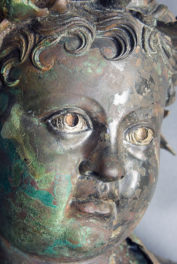
The onions, avocados, and herbs sat in the fridge, neatly packed in baggies that disguised their colorful potential. Each of these unsuspecting items could be used to dye fabrics.
I am a conservator of ancient art, so the use, production, and study of colorful dyes as pigments on ancient artifacts is an important aspect of my work. Now I had an opportunity to play around with items right in front of me, cooling in my fridge and growing in my yard.
Studies of painting materials from the ancient world have revealed a very sophisticated use of natural dyes as colorful pigments, going back thousands of years. Made from plants or insects, these were used not only to tint textiles but also to paint.
Striking examples of this use of color can be seen on mummy portraits, where dyes were mostly used to represent textiles. For example, two ancient mummy portraits in the Getty collection show dyes used in two ways.

Mummy Portrait of a Bearded Man, A.D. 140–160, Romano-Egyptian. Encaustic on lime wood, linen, 16 15/16 × 8 7/8 in. The J. Paul Getty Museum, Villa Collection, 73.AP.94. Digital image courtesy of Getty’s Open Content Program. Indigo-dyed linen in the circle

Mummy Portrait of a Woman, A.D. 175–200, Romano-Egyptian. Tempera on wood, 11 1/8 × 5 11/16 in. The J. Paul Getty Museum, Villa Collection, 79.AP.129. Digital image courtesy of Getty’s Open Content Program. Arrows point at madder and indigo pigment
Mummy Portrait of a Bearded Man has a strip of ancient linen still attached to it that is dyed blue with indigo. In Mummy Portrait of a Woman, the subject wears a bright pink tunic that uses a pigment (called a lake) made of dye from the madder plant. Her blue necklace is colored by indigo. In ancient times, garments like hers would have likely been dyed pink using madder.
Textile, dyeing, and pigment production was an industry in the ancient world. In addition to creating a well-developed process, ancient artisans were resourceful and many materials were recycled for other uses. It’s quite possible that the madder lake used to paint this portrait’s tunic was produced from textile dye baths.
Dye production was not a simple process. Manufacturing dyes and pigments in Egypt, for example, required importing materials from the Mediterranean (like madder root and the parasitic insect kermes) or from as far away as India for the deep blue of indigo. One very special and expensive colorant called Tyrian purple, obtained from the murex shellfish, was “farmed,” requiring thousands of animals to produce just one gram of dye. Whether from an insect, plant, or sea snail, all processes involved dye extraction and complex preparation to make them usable and permanent dyes or pigments. It was likely only the elite who wore brightly colored garments.
At home, I knew indigo and madder are dyes produced from plants, and I also looked to other natural materials to understand the dyeing process. Many plant materials, such as onion skin, avocado pits and skins, and indigo do not require a fixative (mordant) to attach to fibers and become permanent. That makes dyeing from home very easy.

Onion skin, avocado skin and pits, and sage can all be used to dye fabrics

Our dyed fabrics
My son, a high school senior hoping to become a fashion designer, joined me on this journey. Together we hunted for items and cooked up the materials to dye. We grabbed anything we could find: old T-shirts, cloth napkins, table cloths, and kitchen towels were all fair game.
In addition to trying possible methods of dyeing used in antiquity, like pomegranate, onion skins, and herbs, our current experimental goal was to see what range of colors we could achieve and how simple manipulations (such as changing the pH and adding iron) to the water would affect the final outcome.
We ended up with a wide range of reds, pinks, yellow, and tan, but our favorite technique by far was indigo dyeing (not from our yard, but in a nod to modernity, from a kit purchased through Amazon).
The process was magical, like developing photos. We dropped the white fabric into the bath, and when it came out, it appeared green. But as it was exposed to air, it transformed into a magnificent blue.

Throwing avocado pits in boiling water

Dyed fabrics hanging out to dry
While I am interested in ancient technology, my son has incorporated the dyed materials into his modern fashion designs. He mostly creates canvas clothing, and the possibilities for color and paint are endless. For me, my understanding and appreciation of color in antiquity has grown even further.

Dyed blue fabric hanging to dry
As a sea of blue stretched across our yard, I imagined the ancient dyer’s workshop, fabrics blowing in the wind with the Nile or the Mediterranean as a backdrop. Exploring nature’s colors not only illustrated the ingenuity of ancient artisans but also revealed their expressive desire for beautiful things.
This sustainable practice has also become part of contemporary fashion and design, a very good lesson for my son. For me, the lesson was a deeper appreciation of ancient artistic practices. The next time you throw those peels into your trash or compost bin, think about their potential and how color was first discovered and its effect on our daily lives. As Pliny the Elder wrote so long ago, “The most valuable discoveries have found their origin in the most trivial accidents.”
A Few Simple Things to Try
We’ve updated this post with a few very simple steps for dyeing at home with natural materials. Searching the internet and/or picking up a book on natural dyeing will better guide you through the process.
Producing dusty rose/red dye with avocado pits and skins
Start collecting avocado pits and/or skins, clean them, break the pits into smaller pieces and throw them in a one-gallon zip-lock storage bag in the freezer. Collect as many as you can until the bag is more than half full, about 10-20 avocados.
Fill a large stainless steel pot with water, bring to a boil and add the pits or skins. Boil for 60-80 minutes. Strain the liquid (I threw the pits into a stock bag making it easy to remove) into a second large pot. Add thoroughly washed and wetted natural fibers (cotton, wool, or silk) into the dye bath, keep heated for about 30 minutes, remove and let cool.
Let the fabric soak in the dye bath completely immersed for as long as possible, even overnight to obtain the darkest shades. Remove fabrics, wash with dish soap and cold water, and hang to dry in the shade. You should end up with a beautiful red to a dusty rose-colored garment.
Producing yellow dye with pomegranate skins
This is pretty much the same process as above. Collect the pomegranate skins from at least five or more large pomegranates. You can dry or freeze them until you have gathered enough material. Add skins to gently boiling water, let boil for 60-80 minutes, strain and add your presoaked textiles. Keep warm for 30 minutes, remove from heat, and let the fabrics soak for as long as possible (overnight) fully immersed. Remove, wash with dish soap in cold water and hang to dry in the shade. The final product should be a soft, warm yellow garment.
These natural materials do not require a mordant (fixative) but the addition of one (such as a pinch of cream of tartar) or simple manipulations to the bath, such as changing the pH (adding vinegar) or adding vinegar that had a few iron nails soaking in it, can have unexpected and wonderful results.
For beautiful indigo colored blues, Jacquard sells a kit that makes dying easy.
Experiment with other materials you might have hanging around, and have fun.




What kit can u purchase at amazon for producing blue??? Kindly let me know
Dear Ruth,
I do not know what kit she bought but rather than depend on the largest retailers you will do very well if you search for “indigo” on the Lhasa Karnak website ($2.00/oz for powder) that you can use with soda ash or iron and lime or you can use your own urine (instructions for each are searchable). Alternatively, you can poke around under natural dyes on the dharma trading website: https://www.dharmatrading.com/techniques/natural-dyes.html?lnav=techniques.html . I don’t know who runs this company now, but it was started in the 1960s by a woman who opened a tiny shop on College Avenue in Berkeley CA. I used go there for spinning supplies, and she was both humble and very helpful. Once when I asked her if she would teach me how to do some kind of spinning technique, she replied that she couldn’t teach people but that she could show you and you could then learn from doing.
I actually purchased a Rit Indigo Shibori tie dye kit on Amazon, too! I had so much fun with it. They give you instructions and everything you need!
Dharma Trading has all the stuff you will need
https://www.jacquardproducts.com/indigo-tie-dye-kit
This is the kit for indigo dying.
I purchased it through Amazon.
Good luck!
I knew about onion skins to dye eggs, but not about avocado pits. How many and how long to boil them? Do you put salt in the water? How long can you keep the dye and do you have to refridgerate it?
Thank you Iris!
Linda
Dear Marie, what a wonderful article! I do unterstand your and your sons excitement about dying fabrics. That reminds. me. of my. spinning. and dying of fibers 40 years ago,, which I did excessively . Its a wonder. and miracle how the colors emerge out of the water bath. The only. remaining demonstration of my work is a. diary with. my dying recipes and samples. We will start working in. Juli again. I should think about using this tool for. a demonstration in the. gallery. Thanks for the inspiration, All the. Best. Bettina
My friend Natasha, Laura, who is a weaver in Santa Fe, NM, dyes her own yarn. Fascinating process. She also repurposes clothing, using the shibori technique. Natasha has been very creative during these trying times. I really enjoyed your blog. Thank you!
In the 1940’s, my mother boiled eggs with onion skins resulting in beautiful bronze colored Easter eggs with a slight onion flavor. Wonder if sage leaves would impart flavor? Enjoyed your column.
This is a very interesting article and it has given me some ideas for developing activities that incorporate the Next Generation Science Standards for Earth, Physical and Life Science as well as the Engineering Design process. There are also many projects that will incorporate artistic development and creativity. Thank you.
Among the pictures posted, is there an example of the dying the same cloth but with different pH concentrations?
Would it be among the blue cloth?
And as a follow up, are those fruit golden apples died green?
Lastly, the references re the dyers I sense are many less than those for tanners. Might you post a list of both easy to engage as well as more advanced references in English that will march us towards the cliff you sallied off on your endeavor of discovery?
Much fun; thank you.
This post was incredibly inspirational to me and comes at just the right time. being stuck indoors as an elder I am thrilled to have a project to experiment with.
The indigo art hanging in your garden is beautiful!
Thank you,
Deborah
What color did you get from avocado pits? Onion skins? Anything else common in an American kitchen?
What a wonderful story. I love the mixture of hand skills and technology and history. You are an inspiration!
Thank you for this rapturous article on sustainable dyes. “Blue” The History of Color, by Michel Pastoureau is my current read. It is an erudite study of the introduction of the color blue and all its shades.
What fun!! Thanks so much for sharing your experiments with us. i can’t wait to dye all of my white napkins! Such beautiful subtle colors! Do i add anything to the water?besides iron?
Very interesting project. What proportion of water to the natural matter did you use? As a knitter I would like to try dyeing wool with natural material I have had the experience of using chemical dyes.
I am a longterm friend of the Getty. I was on the Photography Council for several years. The Department of Photographs has work of mine in permanent collection.
Among that work are chromes and transparencies from the Middle East circa 1965, including work from a visit to the rural Kurds of Iraq. Utilizing those images, I am now working on a book about the Kurds.
One question relates to plants or other coloration sources of other women’s clothing, made in their home mountain villages in southertn Iraq or en route on migrations. in other parts of Mesopotamia such as Turkey or Iran or Syria. I will try to send you an image, below, showing the kind of clothing I mean; modern and/or ancient origins. It is possible the dyes for these were simply bought locally but perhaps you know of sources of info on this; local plants or animals?
Another, deeper and more complex question has to do with the spectacular, centuries-old Kurdish rugs. Traditionally made by the same women, rug books all say the natural plant sources for dyes were gradually replaced by industrial dyes starting in the late 19th century, which affects the rugs’ dating and value.
These rugs (such as some held in the Met and in European museums) go back centuries as far as the Renaissance or earlier. A fascinating side story is of their likely being exported from today’s Turkey to Venice for notable families in Italy, as well as to other parts of Europe where it was the rage to have images of (Kurdish) carpets in religious paintings (known as a Holbein motif). Far less well documented would be Mesopotamian rug fragments preserved in tombs from BC centuries. I have seen speculative writings on this, by archeologists, but nothing proven or widely known.
I wonder if you know of more current sources on this than I do? Even if not fully proven or accepted, it could help date the early ancestry of the Kurds or their predecessors.
Can you advise, or know who/where to ask?
Many thanks
William Carter
I can only guess that some thoughtless editor reduced the size of you tantalizing article by leaving out the most interesting part… what veggies produced what colors by what process. Aside from a mysterious kit from Amazon practical info for a hobiest to try this themselves seems to be lacking.
Lovely article. I would have loved also recipes, though!
Kind regards,
Francesca Dell’Acqua
I have dyed with fruits and vegetables and the colors are quite fugitive, bright at first, gone in six months sometimes. Most natural dye materials do require a mordant, iron is one you mention. Lichens give beautiful colors and do not require a mordant.
Disappointing! What color does avocado skin/pit yield. You give an add for Amazon to get indigo which we know us fabulous, but not in your garden nor mine..
Marie! This is so beautifully fantastic!!! I’m loving every minute. Thank you so much for sharing this journey you two traveled. Just lovely.
MOST DELIGHTFUL.Will share with Friends MEXICO..WHERE THERE.IS ABUNDANCE OF FRUITS AND VEGGIES, Labeled * Seconds in OPEN Markets. The Photographies LOVELY.. GRATEFUL.
There is an active natural dye and fiber group, Griffin Dyeworks & Fiber Arts, that holds annual retreats right here in Southern California. Not this year, of course, but that hasn’t stopped us from posting classes and interesting information on the griffindyeworks.com site. Come visit!
Marie, Love this essay. I’ve been using lichen to generate brilliant purples and yellows.